Best wireless gaming mice 2024: Tested and approved
Now that wireless gaming mice are just as fast and feature packed as their wired counterparts, going wireless can be a smart move, giving you greater flexibility as a gamer. But before you cut loose and buy one, it’s worth noting they’re not all alike. You’ll still need to consider factors like weight, dots per inch (DPI), and battery life which can be telling factors in how your gaming mouse performs and ultimately how you will perform in games.
Our expert reviewers have put these mice through their paces, testing them across a range of scenarios, and over extended periods of time — you can find out all about our extensive testing process in the article “How we test gaming mice at PCWorld.”
Below are the results of that effort. While these are the current best wireless gaming mice available, for a no holds barred list, including both wired and wireless models, be sure to check out PCWorld’s all-inclusive selection of the best gaming mice.
Why you should trust us: We aren’t just tech enthusiasts we’re also keen gamers and we’re always on the lookout for better gaming gear to get an edge in our favorite games. We know that we’re adding our expertise to a large body of PCWorld product news and reviews that goes back 40 years – that’s credibility we’ve built up over four decades. Consequently, we want to tell you exactly what we find in a product – the good, the bad and the in-between.
Updated April 22 2024 to add the Alienware Wireless Pro and Logitech G Pro X Superlight to our list of recommendations. The Alienware Pro Wireless has a 4KHz wireless polling rate that allows you to track and hit players in FPS games extremely accurately. We rate the Logitech G Pro X Superlight 2 because of its ultra lightweight body and pinpoint symmetry.
Razer Cobra Pro – Best wireless gaming mouse overall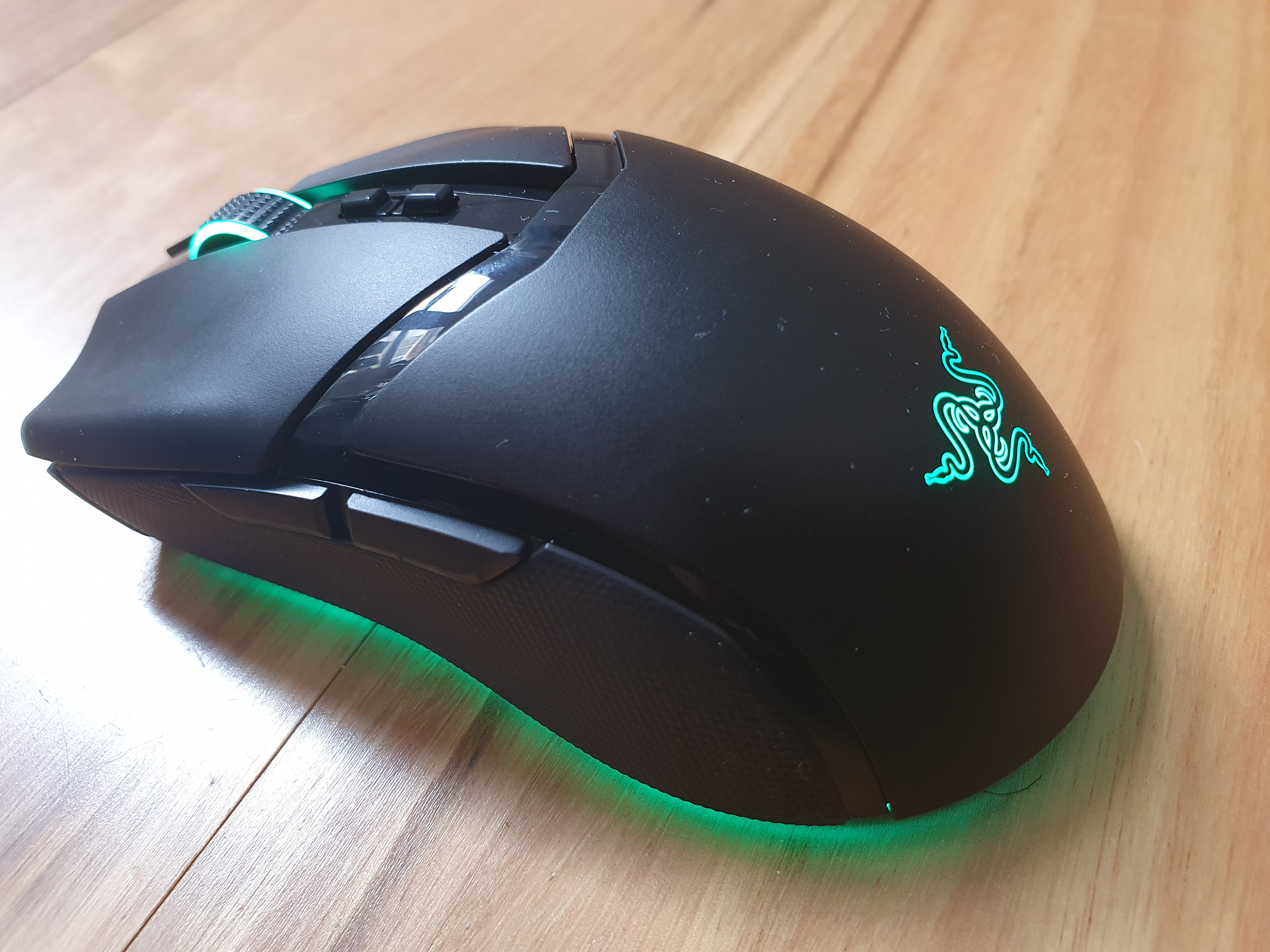


Pros
- Its Razer Focus Pro 30K sensor is superb
- Dedicated DPI up/down buttons makes switching DPI on the fly easy
- Having all 11 zones of RGB is brilliant
Cons
- The dimensions won't suit large hands
- Buying the Cobra Pro with a Hyper polling dongle costs extra
- It's a little heavier than its stablemate the Razer DeathAdder V3 Pro
While some mice have fantastic sensors but fall short in the connectivity department, the Razer Cobra Pro seemingly has it all. It sports both a very high-resolution 30,000 DPI sensor as well as dual wireless connectivity. Not only is its 30K Razer Focus Pro sensor exceptionally smooth and accurate it also allows you to set your preferred lift-off distance from a total of up to 26 granular settings—that’s 23 more than most mice with this functionality.
There’s little to fault about the Cobra Pro’s design either—it’s symmetrical and feels balanced and you also get the benefit of dedicated DPI up/down buttons, which is a rare luxury in pro-grade mice. This allows you to change DPI settings on the fly so you can get the drop on opponents in an instant. To top all that off, the Razer Cobra Pro looks fantastic thanks to 11 programmable RGB lighting zones.
Read our full Razer Cobra Pro review Logitech G502 Lightspeed – Best overall runner-up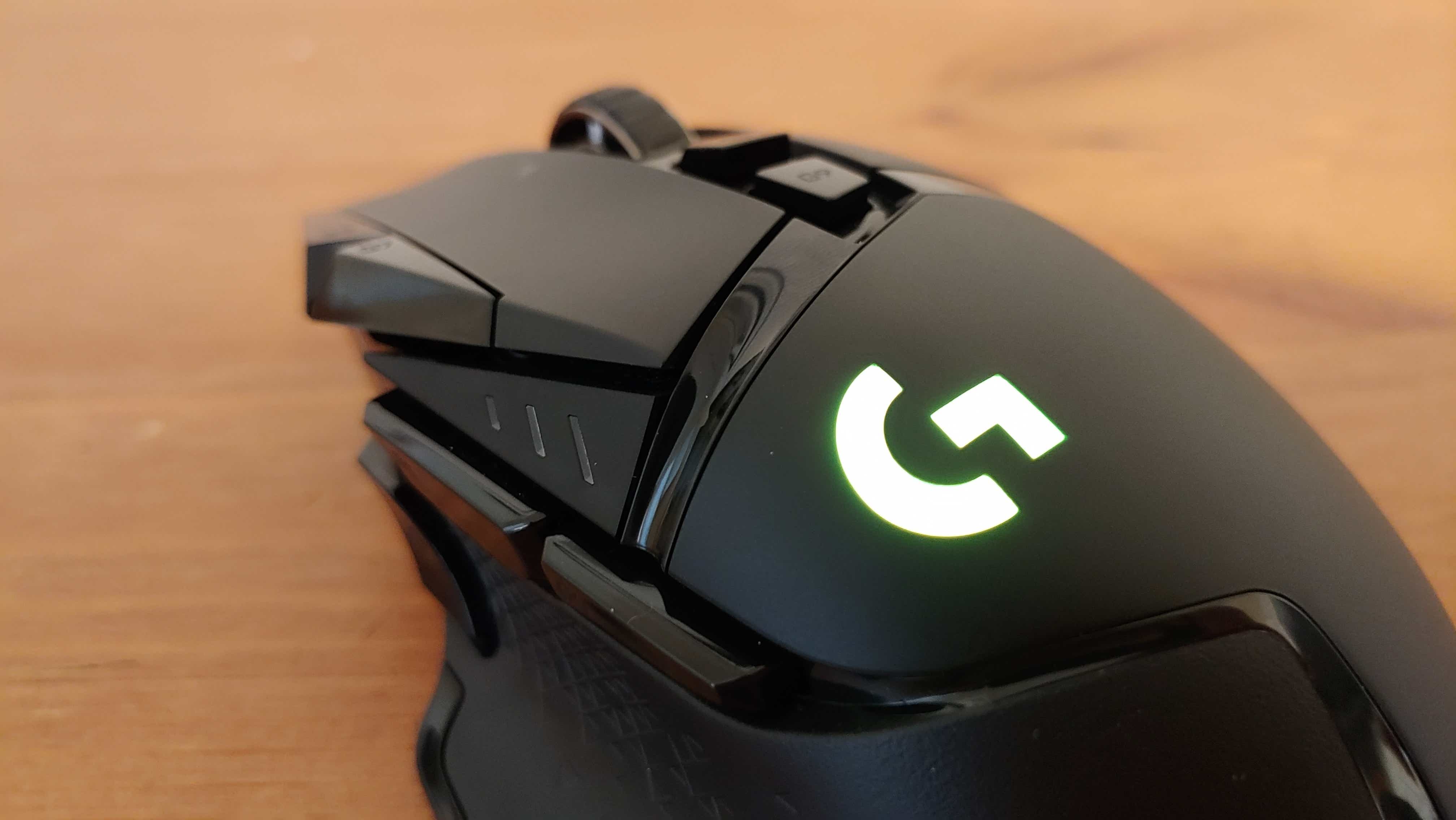


Pros
- Very comfortable design
- Weighs less than the wired version
- Compatible with Powerplay wireless charging mouse pad
Cons
- Scroll wheel feels less substantial
- Weight customization is hampered by Powerplay
- Expensive
The Logitech G502 Hero was a hit with PCWorld reviewers before it went wireless because of its comfortable design, well-thought-out button layout and convenient dual-mode scroll. Thankfully all these features return in the update, but the G502 now has Powerplay compatibility—a feature we can’t speak highly enough of.
The Powerplay system trickle-charges the mouse as you play, freeing you from having to charge it manually, and ensuring you’re never without power (read more about Logitech’s Powerplay Wireless Charging System.) The redesigned wireless G502 also sports a new rubber coated wheel instead of the metal one we saw in the wired version. This change reduces its weight down to just 114 grams, making it the lightest version you can get.
This mouse’s 11-button selection places it in-between mice like the 18-button SteelSeries Aerox 9 and the smaller 6-button HyperX Pulsefire Haste, which makes it ideal as a do-it-all mouse that doesn’t shirk on functionality but won’t overwhelm you with having to remember too many commands.
Read our full G502 Lightspeed review Keychron M3 – Most affordable wireless gaming mouse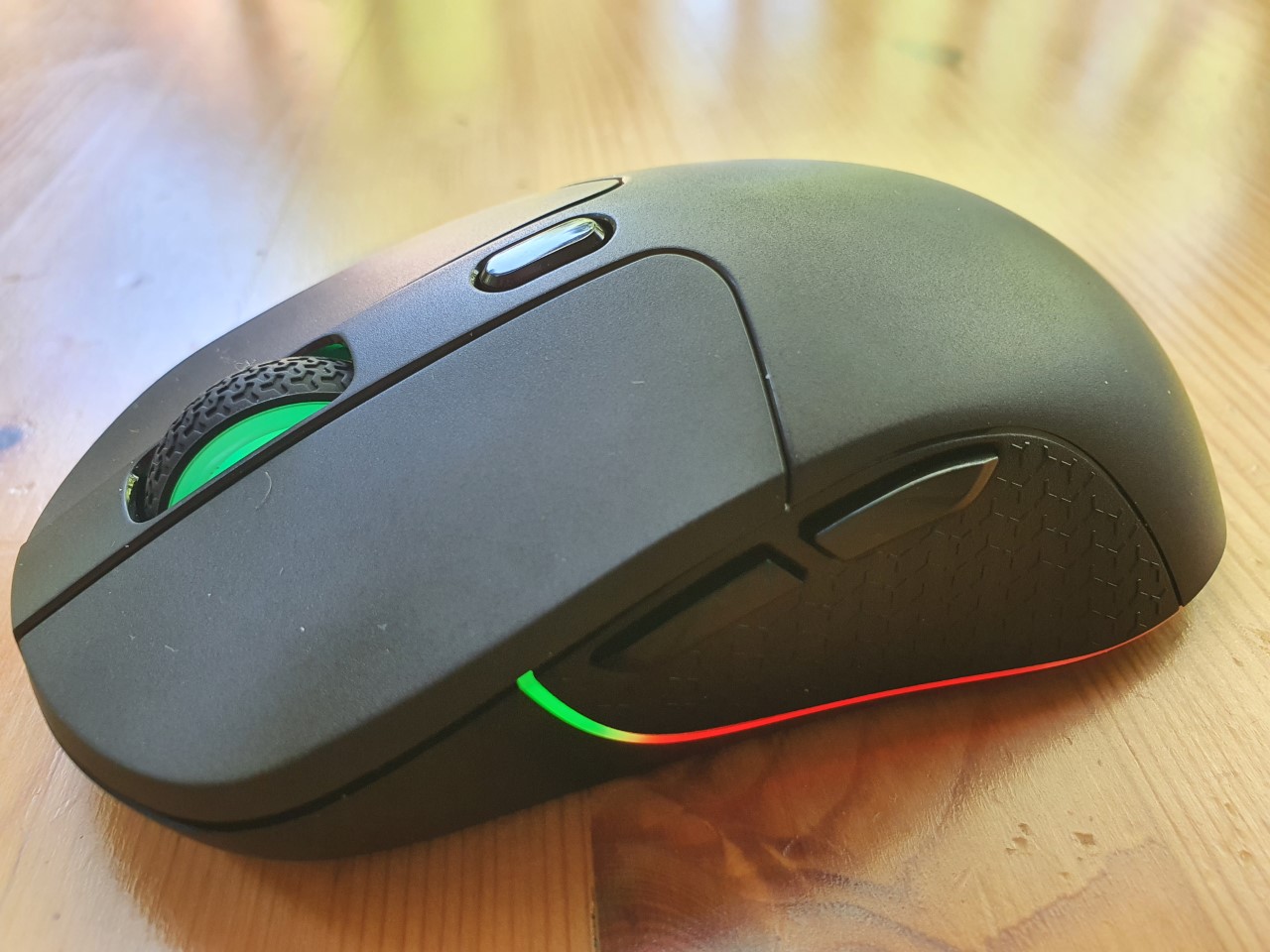


Pros
- Very fast and precise 26,000 DPI sensor
- Well-proportioned and very comfortable
- The quickest buttons I've ever used
Cons
- It would have been more convenient for the DPI button to be placed where the RGB button currently sits
- Mac users will have to wait on a software app
- It's currently only being sold at Keychron's store online
Every once in a while a gaming mouse pops up that blows my mind with how good a value it is. In 2023 that’s definitely Keychron’s M3 gaming mouse that costs just $49. Not only does it sport dual wireless connectivity in the form of low-latency 2.4GHz and Bluetooth 5.1, it also has wired connectivity via a USB cable. Adding to that is a very powerful 26,000 DPI sensor with flawless tracking and some of the quickest buttons I’ve ever used.
But alas there’s more: The M3 also shows off a comfortable, well-proportioned design that weighs just 79 grams, which is exceptionally light considering all that useful wireless connectivity on board. The nine buttons all feel very clean and clicky, but what’s arguably even better is that Keychron has dedicated four of them to various settings, allowing you to change DPI, polling rates, RGB effects, and connectivity modes mid-game without having to go into the mouse’s companion software app.
Read our full Keychron M3 review HyperX Pulsefire Haste 2 Wireless – Best value for money


Pros
- The solid top back is comfortable and stylish
- Its 26,000 DPI sensor can target at lightning speeds
- Bluetooth functionality makes it one of the most versatile esports mice
Cons
- The compact buttons can feel a bit cramped at times
- There's just the one RGB zone to play with
- It's more expensive than its predecessor
Shipping for $89.99 the HyperX Pulsefire 2 Wireless isn’t so much a cheap mouse as it is an excellent value-for-money proposition. By that I mean you’d be very hard pressed to find an esports mouse that weighs just 61 grams, with a 26,000 DPI sensor, dual wireless functionality, RGB lighting, and a compact symmetrical shape for this price. But beyond that, the Haste 2 Wireless is just a stellar performer that will handle even the fastest FPS action with ease.
Additionally, the HyperX Pulsefire Haste 2 Wireless boasts a DPI switch button so you can toggle through DPIs while you play. In regard to its sizing, it’s quite a versatile mouse, easily fitting small, right through to large hands. Although, medium-sized hands will undoubtedly feel the most comfortable on its moderate-sized body.
Read our full HyperX Pulsefire Haste 2 Wireless review Razer Naga V2 Pro – Best wireless gaming mouse for MMO / MOBA games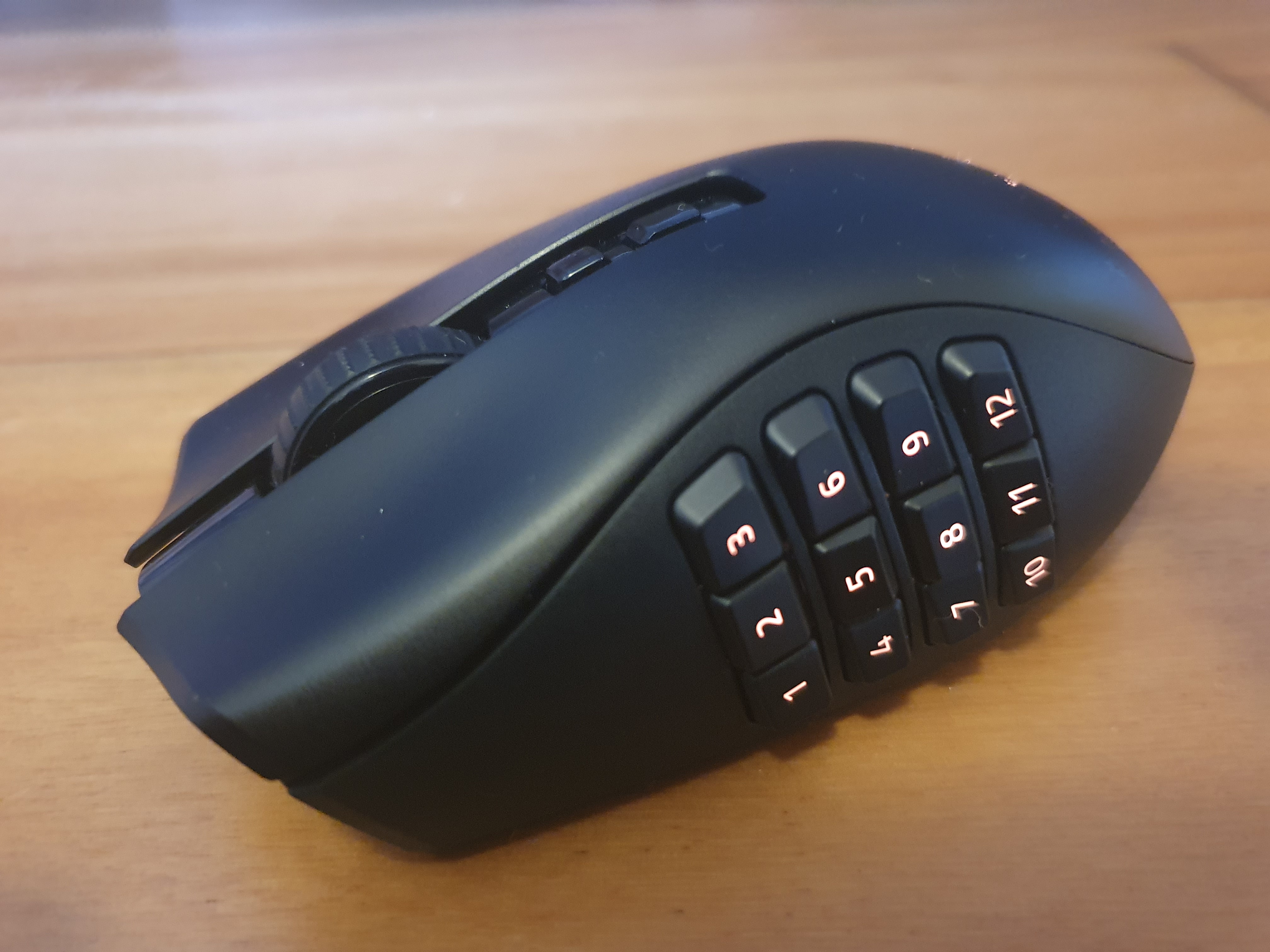


Pros
- The Swappable button plates let you tailor your button setup to your game's command load
- The sensor is very accurate and without a hint of lag
- There's tons of comfort and the build quality is excellent
Cons
- The Razer Gen 3 Optical Switches are a little stiff at first and need wearing in
- It weighs 134 grams which is quite heavy even for an MMO mouse
- It's currently very expensive
The Razer Naga V2 Pro follows in the footsteps of the Razer Naga Trinity, featuring magnetic swappable side-button plates that let you customize your button setup to match your gameplay. The side-button plates include a 12-, 6-, and 2-button option. With the 12-button plate attached you get a maximum of 22 programable commands, which is just ideal for MMO and MOBA gaming. It’s also stacked with upgrades such as a sporty 30,000 DPI pro-grade Optical Sensor, wireless connectivity, and Razer Gen 3 Optical Switches for lighting-fast button responses.
Admittedly, at 134 grams the Razer Naga V2 Pro does weigh a lot even for an MMO mouse. But in my playtesting, I found the weightiness provided a nice authenticity to weapons play that I scarcely ever get from wireless gaming mice. At its current price of $180 USD, it’s also not cheap. But considering how well it performed for me, it’s unlikely you will regret shelling out for such a capable mouse.
Read our full Razer Naga V2 Pro review SteelSeries Aerox 9 – Best for MMO / MOBA games runner-up


Pros
- 18 easily programmable buttons
- Weighs only 89 grams
- Dual Bluetooth 5.0 and 2.4GHz wireless
Cons
- Some buttons on the side grid are hard to reach
SteelSeries Aerox 9 is a rare find among wireless gaming mice in that it packs a whopping 18 programmable buttons but weighs just 89 grams. That makes it an excellent option if you like to tinker with commands and macros in MOBA and MMO games but don’t want to compromise on speed. We also like the Aerox 9 for its fast 18,000 CPI sensor and dual Wi-Fi and Bluetooth connectivity that we found super convenient for switching between laptops in an instant.
With an open top honey-comb design and internal RGB lighting, the Aerox 9 sports a slick, futuristic look that won’t go unnoticed in any group gaming session. It also has the added benefit of being extremely comfortable on hot days, circulating plenty of cool air for your hand.
Although punctuated by a multitude of holes, this mouse is also very sturdy: The top mesh didn’t show any give during our most frantic gameplay. According to SteelSeries, the mouse’s internal hardware is protected against dust and spillage by an IP54-rated Aquabarrier, which is reassuring for gamers like me who like to keep hot beverages close at hand.
Read our full SteelSeries Aerox 9 Wireless review Corsair M75 Air Wireless – Best ambidextrous grip


Pros
- Its narrow high-backed design enables superior control
- The 26K Optical Sensor is quick and reliable
- Up to a quick 2000Hz / 0.5ms default polling rate
Cons
- One button for Bluetooth and Wi-Fi can be confusing
- There's just one on-board memory profile
- No DPI switcher button
Corsair’s M75 Air is an FPS performance dynamo just based on how smooth and precise its 26K Optical Sensor was in my playtesting, but it also felt really comfortable too. It boasts a symmetrical chassis with a high back and narrow front that allows it to work equally as well with all the major grip types. The mouse’s five-button configuration sports two buttons on the left-hand side that are very low-set, which along with its symmetrical body, means it’s a great mouse for switching hands with.
With no DPI button, the M75 Air doesn’t give you the option of switching DPIs on the fly. But it does have a not-so-vanilla 2,000Hz default polling rate, which I was super happy with, since it’s an improvement on the default 1,000Hz sensor reporting rate I often get in FPS mice. Thanks to extremely well-placed horseshoe shaped PTFE feet, this mouse also glides over a mouse mat or tabletop like a dream.
Read our full Corsair M75 Air Wireless review Razer DeathAdder V3 Pro – Best pro-grade wireless gaming mouse


Pros
- Ultra light and quick off the mark
- Perfectly chiseled to the contours of your hand
- The 30,000 DPI sensor is very impressive
Cons
- It'll cost you extra to upgrade to 4000Hz hyper polling
- Has fewer buttons than its predecessor
- DPI button is located on the underside
The Razer DeathAdder V3 Pro has everything you need to perform at your best in quick, competitive matches, including a comfortable ultra-lightweight 63-gram design that’s perfectly chiseled to the contours of your hand, a flawless 30,000 DPI optical sensor, and very quick Razer Gen 3 Optical Switches in the buttons, which incidentally are some of the quickest I’ve used.
Better still, the V3 Pro incorporates a few sweetener technologies that can provide big performance boosts if you’re willing to take the time to apply them. Two of these are, Asymmetric Cut-off distance, and hyper polling. The former lets you set a very precise landing distance up to 26 granular levels of adjustment—that’s 23 levels more than what you get in some pro-grade gaming mice. The latter, ramps up the V3’s default 1,000Hz polling rate to a lightning-quick 4,000Hz, although you will need to shell out an extra $29.99 for a HyperPolling dongle for the privilege.
And, therein lies the biggest drawback with the V3 Pro—its cost. It’s currently wearing a $150 USD price tag which makes it quite an investment. Still, if you’re looking for the very best performance you can get, it’s totally worth it.
Read our full Razer DeathAdder V3 Pro review Logitech G Pro X Superlight 2 – Best pro-grade wireless gaming mouse runner up


Pros
- Symmetrical body provides nice accuracy
- Ultra lightweight – it weighs over just 2 ounces
- Quick and accurate 32,000 DPI sensor
Cons
- The mouse wheel feels a bit flimsy
- No Bluetooth connectivity
- It's expensive
The Logitech G Pro X Superlight 2 is the successor to one of the most favored mice by big-name esports athletes. Consequently, it sports some kick-ass functionality. A premium-level, very accurate 32,000 DPI sensor and a lightweight symmetrical body are its best assets, that make it a cinch to move and aim. It also comes in a range of stylish colors.
The mouse’s high back is also as comfortable as they come, it presses into your palm providing lots of support for long gaming sessions, where you just want to immerse yourself in your gaming and not have to worry about how your wrist or arm feels. If quick jerky firefights in FPS games are your jam, search no more — this mouse is just what you need.
Read our full Logitech G Pro X Superlight 2 review
If you want to size up every FPS option before you buy, two other excellent FPS gaming mice we recommend are the Logitech G Pro X Superlight and the ROG Harpe Ace Aim Lab Edition.
Roccat Burst Pro Air – Best RGB lighting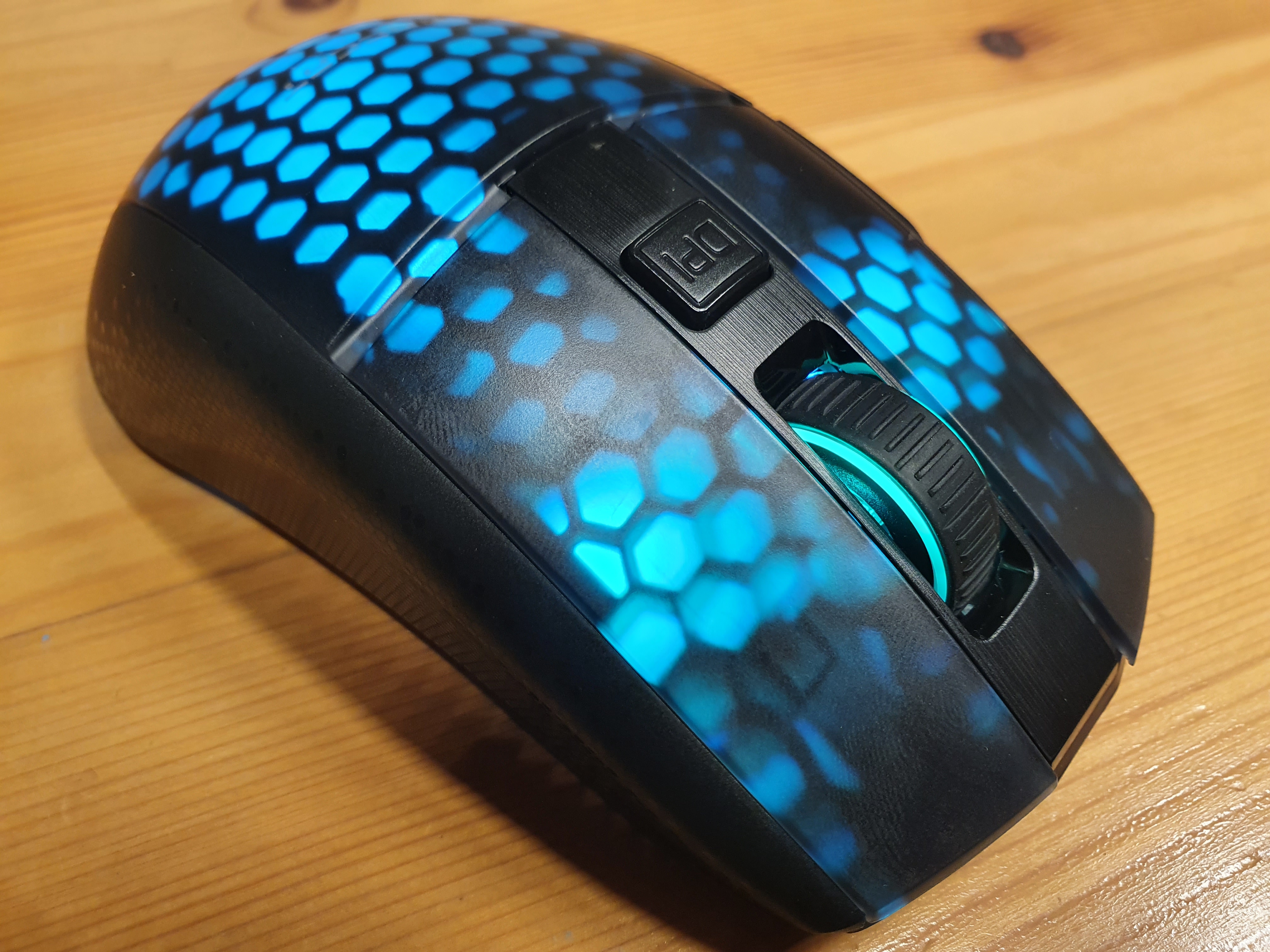


Pros
- Owl-Eye sensor is very precise and quick
- You won't find a mouse with more stunning RGB lighting
- Dual wireless as well as wired connectivity
Cons
- 81-gram weight can feel heavy if you're used to a lighter mouse
- Mouse wheel lacks left and right lateral clicks
- Pricey compared to some rivals
While some gaming mice only have limited RGB lighting around their buttons or periphery, the ROCCAT Burst Pro goes all out with four dedicated programmable RGB lighting zones that light up the whole mouse like a firecracker. Suffice to say, with 16.8 million color options in Roccat’s Swarm software app to play with, you can get some dazzling lighting effects on this mouse.
But while the Pro Air is genuinely stunning to look at, it’s equally as proficient in games, thanks to its comfortable eight-button configuration, powerful 19,000 DPI Owl-Eye optical sensor, and low-latency switches, which have a 100-million click durability rating.
The Pro Air is also an extremely versatile mouse, thanks to its multiple connectivity options, which include a low-latency 2.4GHz Wi-Fi, Bluetooth 5.2, and a USB-A to USB-C cable for wired connectivity.
Read our full ROCCAT Burst Pro Air review Alienware Pro Wireless Gaming Mouse – Most versatile esports mouse


Pros
- 4KHz wireless polling rate
- The buttons are soft and have a quick debounce
- The Alienware styling looks awesome
- One of the most precise mouse wheels I've used
- Weighs just over 2 ounces
Cons
- The back could do with more height
- There's no RGB lighting
- It's quite large so won't suit everyone
Gaming mice manufacturers are gradually releasing their premium grade esports mice to include 4KHz polling rates, a reporting rate so quick that previously only tethered mice had it. The Alienware Pro Wireless isn’t the first to have this functionality, but it is one of the first to make it a feature right out of the box, without you needing to pay for an additional hyper-polling dongle.
That functionality alone means you’re going to get the quickest wireless reporting rate for aiming and tracking players in FPS games that you can in a wireless mouse. But it’s not the only thing that makes the Pro Wireless such an excellent performer for esports. It also has a very precise 26,000 DPI sensor, very soft buttons with a very quick debounce, and a comfortable symmetrical grip that is perfectly molded to your hand. If you need more speed and precision in your game, one of these speed demons is just what the doctor ordered.
Read our full Alienware Pro Wireless Gaming Mouse review Cherry Xtrfy M8 Wireless – Most versatile for esports runner-up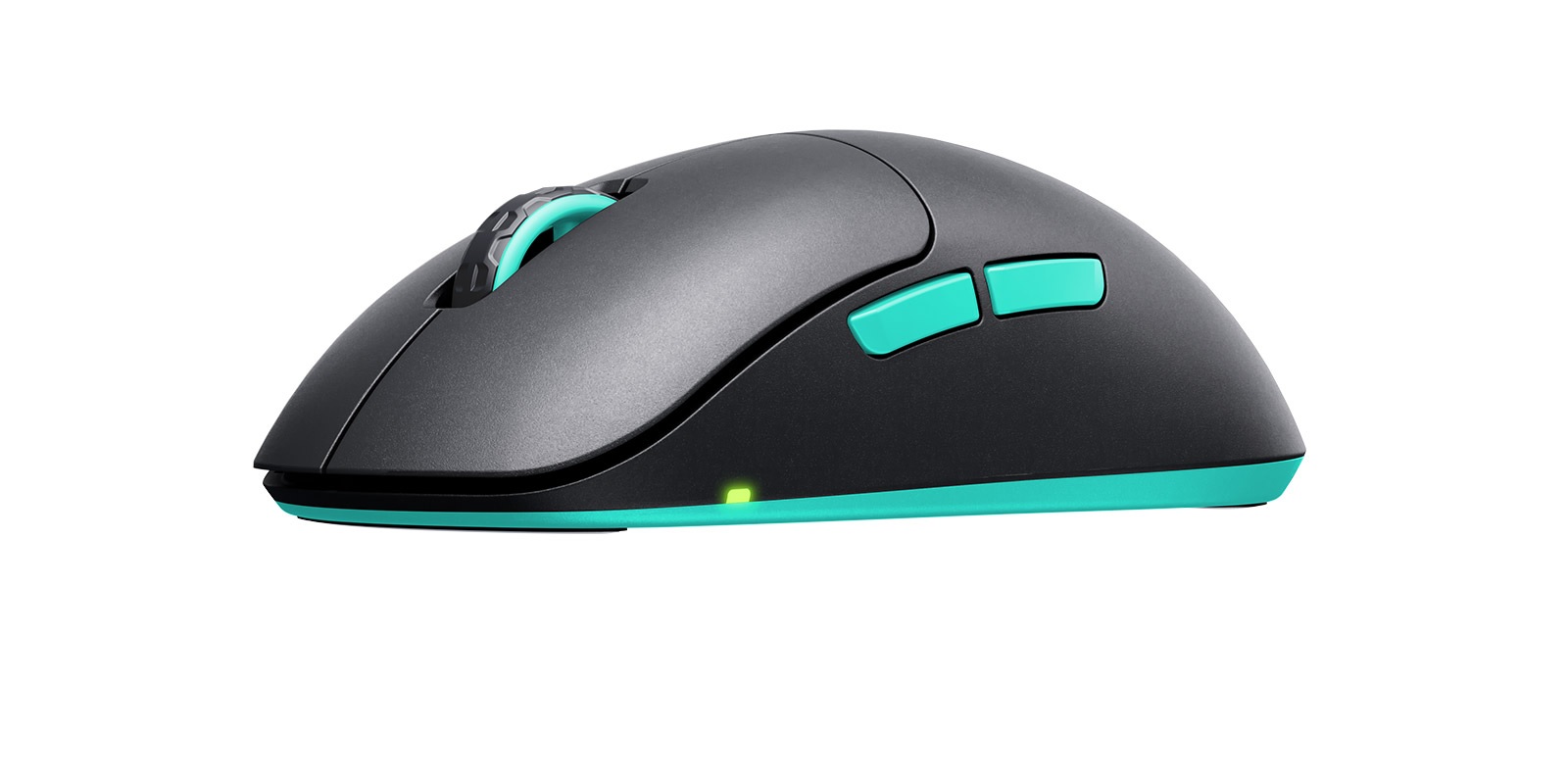


Pros
- Very good sensor
- Ultra-flat front
- Very light
- Fast wireless connection
- Eco-friendly design
- Long battery life
Cons
- Unusually placed charging socket
- Design might take some getting used to for some users
With an ultra-light four-button design weighing just 55 grams, the Cherry Xtrfy M8 Wireless mouse is an optimal weight for esports gaming. It comes equipped with a Pixart 3395 optical sensor with a maximum resolution of 26,000 DPI and super-quick Kailh GM 8.0 mouse switches in its buttons. Both of these pieces of hardware are highly suitable for pro-grade gaming: The sensor proved extremely precise in our play testing, offering precise control and accuracy. The switches feature a high durability rating of 80 million clicks.
The M8 Wireless features the convenience of 2.4GHz Wi-Fi connectivity with a low-latency response time of less than 1ms. It’s also a great option for gamers who like fine control of their mouse’s actuation speed, since you can adjust the debounce time to 2, 4, 8, or 12 milliseconds.
On the whole this mouse has a comfortable and practical design. It does, however, have an unusually placed charging socket located on its right-side. Cherry claims the M8 Wireless’s housing is made from 60 percent recycled plastic, which makes it one of the eco-friendlier gaming mouse options on the market today.
Read our full Cherry Xtrfy M8 Wireless review MSI Clutch GM51 Lightweight Wireless – Easiest to recharge


Pros
- Charging dock included
- Long battery life
- Current high-end sensor from Pixart
- Omron switches
- Three connection modes (2.4GHz, Bluetooth, wired)
- Good price-performance ratio
Cons
- A bit heavy for "Lightweight"
- Software is a little convoluted
The MSI Clutch GM51 is flanked by unique RGB Diamond Lightgrips that bestow a drool-worthy gamer-centric look. These grips also provide your hand with excellent grip and precision control of movement. For hardware, this mouse boasts quick Omron Switches in its buttons and a 26,000 DPI Pixart PAW-3395 sensor supporting three-pronged connectivity — 2.4GHz Wi-Fi, Bluetooth, and a wired connection.
In our playtesting we found the sensor to be very fast and precise. It was also extremely smooth thanks to an MSI technology called “Motion Sync” that kept our mouse movements precisely in sync with our game.
By far one of the best features of the GM51 is its excellent rechargeability. Not only does it come with a convenient charging dock, but it’s also one of the fastest USB charging mice you can buy, with 15 minutes charging time being all that’s needed for 27 hours of wireless play.
Read our full MSI Clutch GM51 Lightweight Wireless review SteelSeries Rival 650 – Best for lifters


Pros
- Gets 10 hours of charge in only 15 minutes
- Comfortable and attractive design
- Removable weight system provides plenty of options
Cons
- Heavier than some might like
- Expensive
- Third thumb button is small and awkwardly placed
On the surface, the SteelSeries Rival 650 could be any other wireless gaming mouse, but dig a little deeper and you’ll find it has two big advantages over rivals—its dual sensor hardware configuration and its fast charging capability.
To improve your accuracy, the Rival 650 pairs a primary sensor, the PWM3360 TrueMove 3, with a dedicated depth sensor whose job is solely to cease input when your mouse leaves your mousepad. If you mainly keep your mouse flat on your mouse pad or table top, chances are you won’t notice much difference in your gaming accuracy. However, if you do lift your mouse a lot, this feature should make aiming a tad easier.
SteelSeries claims 15 minutes fast charging is all the Rival 650 needs to run for 10 hours straight. We put this claim to the test and found it to be mostly true; 15 minutes or sometimes just a few minutes more was enough to power it through more than a day of gaming, which made us very fond of this mouse.
Read our full SteelSeries Rival 650 review Razer Viper V3 Hyperspeed – Best replaceable battery option


Pros
- Quick and accurate sensor
- High sensor positioning
- Very long battery life
- Hyperpolling support
Cons
- No RGB lighting
- 2.4GHz Wi-Fi connectivity only
- Weighs less than 3 ounces
It may sport modest looks, but the six-button Razer Viper V3 HyperSpeed is a real performance juggernaut. With its extremely quick and accurate 30K Razer Focus Optical Sensor, 1,000Hz polling rate, and a chassis that weighs less than 3 ounces, this mouse is built for speed right out of the box. But what really made it cook with fire in my playtesting was the mouse’s high sensor positioning, which registered my hand’s movements at its origin point, so a little quicker than I’ve experienced with some other six-button FPS mice.
The Razer Viper V3 HyperSpeed is also unique in its class in that it houses a single AA battery instead of a rechargeable one. That means you get a little extra battery life than some FPS mice in Razer’s lineup; Razer says it gives you up to 280 hours with the default 1,000Hz polling rate, or 75 hours at the maximum 4,000Hz HyperPolling rate. That outdoes the Razer DeathAdder V3 Pro by 190 hours at 1,000Hz and by 51 hours at 4,000Hz. A downside is that if you want 4,000Hz HyperPolling functionality, you’ll need to buy an additional part from Razer’s website. This mouse also lacks Bluetooth connectivity.
Read our full Razer Viper V3 Hyperspeed review How we test wireless gaming mice
To make sure our wireless gaming mice picks are the best of the best, the PCWorld team puts them through a legion of tests. We look at everything from how well they’ve been designed and perform in games, to the suite of software that helps you personalize them. Here’s a list of the main categories our tests fall under:
- Design and ergonomics: Here we factor in the mouse’s physical characteristics, including its shape, styling, buttons, and RGB lighting (if any). We also consider how comfortable it is, what size hands it fits and, importantly, what grip type it will ideally suit (palm, fingertip, or claw). Last of all, we consider how tough it is, including how likely it is to survive the rigors of gaming life.
- Wireless performance: This is the fun part of our testing where we get to try out our mouse in a bunch of games, while at the same time evaluating factors like its tracking accuracy, sensitivity, and how fast it reacts to our movements. We’re testing the mouse’s sensor in a big way here, but also our mouse’s wireless, and or Bluetooth connectivity.
- Software support: What you can actually achieve with your wireless gaming mouse sometimes comes down to what its supporting software allows. When testing our mouse’s software app we consider how easy it is to navigate, change settings, program buttons, set up profiles for games, and make changes to RGB lighting (if any).
For more details about our evaluation process, see our article on how we test gaming mice at PCWorld.
FAQ 1. Does having a gaming mouse really matter?If you plan on doing any gaming, it absolutely is better to opt for a gaming mouse over a regular office mouse. That’s simply because gaming mice boast hardware and design benefits over regular office mice that make them eminently faster, more comfortable, and more accurate. The sensor and the buttons are the two most obvious features that have been enhanced in gaming mice.
For example, while the average office mouse is lucky to have just a measly 8,000 DPI resolution sensor, we’re now seeing gaming mice with sensors that have resolutions of more than 26, 000 DPI, which makes them a lot faster and more accurate.
In mice like the Razer DeathAdder V3 Pro the buttons feature 3rd-generation Razer Optical Switches, which actuate in less than 0.2 milliseconds—much less than the typical 1 millisecond average in office mice. What’s more, gaming mice are usually more customizable, allowing you to program specific commands to your buttons so that you can just fire them off at will in games.
2. Connectivity: Wireless or Bluetooth or both?Some wireless gaming mice have Bluetooth as well as 2.4GHz wireless connectivity and let you switch between the two. Having Bluetooth is considered a luxury that gives you the versatility of being able to use your mouse with more devices, like your tablet or gaming console. It also offers you the advantage of a dongle-less connection on the go, which can be very handy for school or work.
Still, there are at least two good reasons why you might still opt for a mouse with only Wi-Fi connectivity. Number one is Bluetooth-capable gaming mice tend to be slightly heavier than mice with just Wi-Fi connectivity alone. Also, a Wi-Fi connection is ultimately a lot faster and more stable, so if you do a lot of competitive gaming, Bluetooth won’t be the best option for that.
3. Do esports players use wireless mice?At one time it would have been unheard of for an esports players to use wireless mice because of the slight millisecond or so lag that they used to have compared to conventional wired options. Nowadays, however, thanks to 2.4GHz Wi-Fi connectivity, any such latency difference has all but been eradicated. That said, it’s now not uncommon for most professional esports teams to have at least one player using a wireless mouse.
One example is team Natus Vincere that includes Ukrainian professional CounterStrike: Global Offensive player Oleksandr Kostyliev, aka S1mple, who has achieved spectacular results with his wireless Logitech G Pro X Superlight.
4. Are there any disadvantages to using a wireless mouse?While the difference in latency between top-level and wireless mice is almost imperceptible these days, there can still be disadvantages to choosing wireless gaming mice over wired ones. One is that the lightest wireless gaming mice tend to be slightly heavier than the lightest wired gaming mice. This weight difference is usually only a few grams. Still, for esports professionals even a few grams can make a difference to their overall performance.
The other obvious thing worth noting, is you’ll need to ensure you don’t lose the mouse’s wireless dongle. Wireless dongles can be small and easy to misplace. Losing your dongle could render your gaming mouse essentially useless—something that you needn’t worry about in wired gaming mice.
5. Is my mouse’s sensor really important?A gaming mouse’s sensor is the number one hardware component that determines how well a mouse performs in games. The sensor decides the mouse’s tracking speed and accuracy, two factors we scrutinize in our tests. The main spec to look for in any sensor is dpi (dots per inch), which tells you how well the mouse’s sensor reports movement per inch of physical movement. The newest wireless gaming mice have dpi ranging from 12,000 to 30,000, with higher numbers indicating mice with greater sensitivity.
While a lot of fuss is made about dpi in manufacturer brochures, there’s really no perfect dpi for gaming, it being largely a personal choice. While it can’t hurt to have the best, unless you’re a professional esports gamer you probably won’t need a 30,000 dpi sensor. In reality, even 12,000 dpi provides decent performance in games.
6. Orientation: right, left, or ambidextrous?Are you left or right-handed, or ambidextrous? For practicality’s sake the answer to this question should inform your choice when buying a wireless gaming mouse. That way you’ll get a better fit for your hand shape and the buttons will be within reach of your fingers. While most of our wireless gaming mice reviews are of right-handed mice, simply because that’s what most people use, we’ll endeavor to bring you left-handed and ambidextrous mice reviews when possible.
7. What grip type do I use?How you grip your mouse is not something you’ve probably given much thought to—just like you don’t give much thought to how you hold your fork when you eat. Still, it can be important since you’ll want to get a mouse that fits your specific grip type. The three main grip types are:
Palm grip: This is the most common type of mouse grip among gamers. It’s also the most comfortable for long gaming sessions since it puts more of your hand in contact with your mouse and prevents tension in your wrist. For palm grippers, long, flat mice tend to be a better fit and more comfortable.
Claw grip: If you use a claw grip, you’re arching your palm over the mouse to make a claw shape. This grip is popular in the e-sports community, especially among FPS players, since it allows you to make quick wrist movements—useful for sweeping attacks on targets. It does however clench the wrist and cause some tension there. Narrower and smaller mice suit a claw grip.
Fingertip grip: This grip provides you the least amount of control but the most dexterity for aiming. Gamers who use this grip mainly use just their fingertips on the left and right clicks, putting a lot of strain on their wrists. Because of the added strain, lighter mice are often preferred by fingertip grippers.
8. Should I buy a light or heavy mouse?A mouse’s weight can have a big impact on how accurately you can target and position its curser or crosshairs. Gamers these days tend to go for the lightest mice available since they require less effort to move and are also naturally faster.
Lighter mice also lend themselves to longer gaming sessions, since gamer hands (and arms) aren’t as easily fatigued by them. Wireless gaming mice are among the lightest available because they are unencumbered by wires.
One thing to note about a mouse’s weight is that whether it’s considered light is relative to how many buttons it has. For example, the 18-button SteelSeries Aerox 9 Wireless might seem like a heavyweight at 89 grams compared to the six-button / 61-gram HyperX Pulsefire Haste, yet for an 18-button mouse it’s considered exceptionally lightweight.
9. How many buttons do I need?The type of games you play should help you decide how many buttons you need. If you’re mainly into FPS (first-person shooters) a wireless gaming mouse with six buttons—which tends to be the minimum number we see in wireless gaming mice these days—should be more than enough.
On the other hand, if you play games where you need to quickly deploy lots of commands—like MOBA and MMO games—a mouse with between 6 and 18 buttons will provide you with more versatility.
10. Why is software so important?If your mouse is your weapon in games, then the mouse’s support software is its armory. The best software apps for wireless gaming mice allow you to change and customize settings like your mouse’s sensitivity and acceleration and deceleration. They also let you set commands and macros and save your preferences in profiles that you can easily switch to when you want to play specific games.
Technology Industry